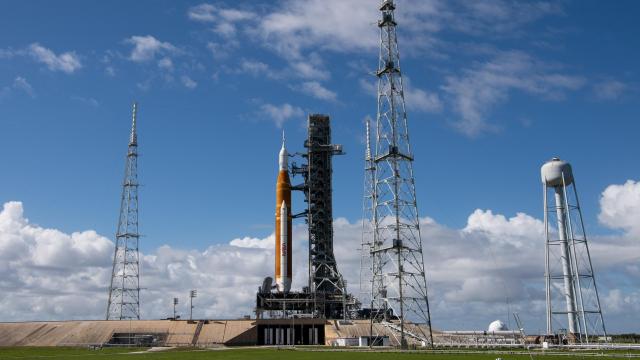Monday, November 14 was supposed to be the day that the Space Launch System finally takes flight, but a late-season tropical storm has forced NASA to bump the launch back, but thankfully not by a whole lot. The space agency opted to leave SLS on the launch pad, saying it’s designed to withstand storms of this magnitude.
I’m in the Eastern Time Zone, so I was all ready to stay up late on Sunday to watch the early Monday morning Artemis 1 launch, but it now appears that I’ll have to stay up late on Tuesday to watch — hopefully — a very early Wednesday morning launch. I have an upstart tropical storm named Nicole to thank for this disruption in my schedule. Of course, the folks on the ground at Florida’s Kennedy Space Centre, who are in batten-down-the-hatches mode, have it worse. That said, they won’t be shuttling the rocket back to the garage for shelter, which means SLS will have to ride out the storm.
NASA’s newly announced two-hour launch window opens at 5:04 p.m. AEDT on November 16. That’s not my favourite time to be awake (at least, not mid-week), but I wouldn’t miss this event for the world. The 97.84 m-tall SLS rocket has been in the works since 2011, resulting in a rather long wait. SLS is key to NASA’s Artemis program, which seeks a sustainable and sustained return to the lunar environment. A backup launch opportunity is available on Saturday, November 19.
More on this story: Artemis 1: To Boldly Go Where Four RS-25 Engines Have Gone Many Times Before
Should all go as planned, SLS will launch an uncrewed Orion spacecraft on a 25-day journey to the Moon and back, with a splashdown in the Pacific on Friday, December 11. The caveat is that Nicole passes through this week without causing any damage to Kennedy and the SLS launch infrastructure. Wednesday’s planned launch is “pending safe conditions for employees to return to work, as well as inspections after the storm has passed,” NASA says.
Kennedy Space Centre is currently in HURCON II status as a result of the storm. This was preceded by HURCON III mode, in which the staff secured the facilities, property, and equipment, and also organised a ride-out team. NASA entered into HURCON II at 2:00 a.m. ET this morning, requiring non-essential Kennedy personnel to stay home. The ride-out team will stay and monitor conditions at the facility, including the state of SLS and Orion.

Despite the incoming storm, NASA will not be rolling SLS back to the Vehicle Assembly Building for shelter, which it did in late September when Hurricane Ian threatened the Florida peninsula. SLS can withstand sustained winds reaching 137 km per hour, and current forecasts are calling for less. But at predicted sustained winds of 113 km/hr, that’s only slightly less. NASA better hope it made the right decision by leaving the $US4.1 ($6) billion rocket on the launch pad as a possible hurricane sweeps past.
That said, ground teams did prepare for the storm. Orion, the SLS core stage, the interim propulsion stage, and the boosters have all been powered down. “Engineers have also installed a hard cover over the launch abort system window, retracted and secured the crew access arm on the mobile launcher and configured the settings for the environmental control system on the spacecraft and rocket elements,” the space agency said. Ground teams ensured that all nearby hardware was secured, while also removing potential debris in the vicinity of the jumbo rocket. NASA says SLS can also handle intense rains.
Once Nicole passes, ground teams will perform inspections of both the facility and the rocket to confirm that everything is tickety-boo. Assuming that’s the case, the launch team can resume its normal work and prepare for Wednesday’s launch attempt. Again, Wednesday’s very early launch attempt. My coffee maker and I will be ready.
More: NASA Pushes First Operational Boeing Starliner Mission to 2024
